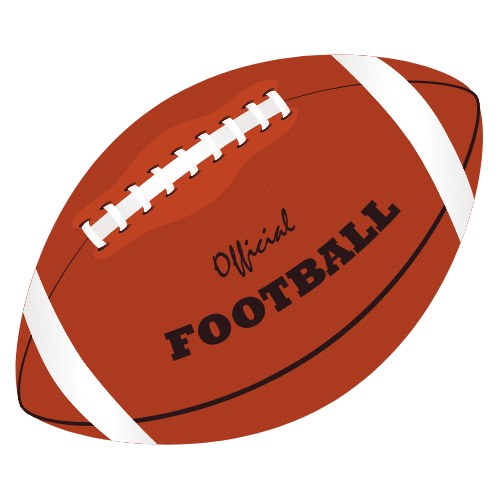Rule 6 - Kicks
SECTION 1. Free Kicks
Article 1 - Restraining Lines
For any free kick formation, the kicking team’s restraining line shall be the yard line through the most forward point from which the ball shall be kicked, and the receiving team’s restraining line shall be the yard line 10 yards beyond that point. Unless relocated by a penalty, the kicking team’s restraining line on a kickoff shall be its line 15 yards from the midfield line, and for a free kick after a safety, its 20-yard line.
Article 2 - Free Kick Formation
a. A ball from a free kick formation must be kicked legally and from some point on Team A’s restraining line (Exception: Rule 6-1-2-c-4)
and on or between the hash marks. The referee will declare the ball ready for play when the officials are in position after the kicker has received the ball. After the ready-for-play signal, the ball may only be relocated after a charged team timeout and before a subsequent kick. After the ball is ready for play and for any reason it falls from the tee, Team A shall not kick the ball and an official shall sound his whistle immediately.
b. After the ball has been made ready for play:
1. All players on the kicking team, except the kicker, must be no more than five yards behind their restraining line. A player satisfies this rule when one foot is on or beyond the line five yards behind the restraining line. If one player is more than five yards behind the restraining line and any other player kicks the ball, it is a foul for an illegal formation [S19: IFK]. (A.R. 6-1-2:VII)
2. All players on the kicking team, except the kicker in his kicking motion and the holder for the purposes of holding the ball, must remain behind their restraining line [S18: OFK].
3. If a Team A player attempts to kick the ball but misses it (intentionally or accidentally), it is a dead-ball foul for illegal procedure [S19: IFK].
c. When the ball is kicked (A.R. 6-1-2:I-IV):
1. Each Team A player, except the holder and kicker of a place kick, must be behind the ball [S18: OFK]. (A.R. 6-1-2:V)
2. All Team A players must be inbounds [S19: IFK].
3. At least four Team A players must be on each side of the kicker [S19: IFK]. (A.R. 6-1-2:II-IV)
4. After a safety, when a punt or drop kick is used, the ball may be kicked from behind the kicking team’s restraining line. If a yardage penalty for a live-ball foul is enforced from the previous spot, administration is from the 20-yard line, unless the kicking team’s restraining line has been relocated by a previous penalty [S18 or appropriate signal].
5. All players of Team A must have been between the nine-yard marks after the ready- for-play signal [S19: IFK].
PENALTY − [b3] Dead-ball foul. Five yards from the succeeding spot. [S19: IFK]. [a-c5 except b3] Live-ball foul. Five yards from the previous spot, or five yards from the spot where the subsequent dead ball belongs to Team B, or from the spot where the ball is placed after a touchback [S18 or S19: IFK/OFK]. (A.R. 6-1-2:VI)
6. All Team B players must be inbounds [S19: IFK].
7. All Team B players must be behind their restraining line [S18: OFK].
PENALTY − [c6-c7] Live-ball foul. Five yards from the previous spot [S18 or S19: IFK/OFK].
Article 3 - Touching and Recovery of a Free Kick; Illegal Touching
a. No Team A player may touch a free-kicked ball until after:
1. It touches a Team B player (Exception: Rules 6-1-4 and 6-5-1-b);
2. It breaks the plane of and remains beyond Team B’s restraining line (Exception: Rule 6-4-1)
(A.R. 2-12-5:I); or
3. It touches any player, the ground, an official or anything else beyond Team B’s restraining line.
Thereafter, all players of Team A become eligible to touch, recover or catch the kick.
b. Any other touching by Team A is illegal touching, a violation that, when the ball becomes dead, gives the receiving team the privilege of taking the ball at the spot of the violation.
c. If there is an accepted penalty for a live-ball foul by either team, or if there are offsetting fouls, the illegal touching privilege is cancelled. (A.R. 6-1-3:I)
d. Illegal touching in Team A’s end zone is ignored.
Article 4 - Forced Touching Disregarded
a. A player blocked by an opponent into a free kick is not, while inbounds, deemed to have touched the kick. (A.R. 2-11-4:I)
b. An inbounds player touched by a ball either batted or illegally kicked by an opponent is not deemed to have touched the ball (Rule 2-11-4-c).
Article 5 - Free Kick at Rest
If a free kick comes to rest inbounds and no player attempts to secure it, the ball becomes dead and belongs to the receiving team at the dead-ball spot.
Article 6 - Free Kick Caught or Recovered
a. If a free kick is caught or recovered by a player of the receiving team, the ball continues in play (Exceptions: Rules 4-1-3-g, 6-1-7, 6-5-1 and 6-5-2). If caught or recovered by a player of the kicking team, the ball becomes dead. The ball belongs to the receiving team at the dead-ball spot, unless the kicking team is in legal possession when the ball is declared dead. In the latter case, the ball belongs to the kicking team.
b. When opposing players, each eligible to touch the ball, simultaneously recover a rolling kick or catch a free kick, the simultaneous possession makes the ball dead.
c. A kick declared dead in joint possession is awarded to the receiving team.
Article 7 - Ball Dead in End Zone
a. When a free kick untouched by Team B touches the ground on or behind Team B’s goal line, the ball becomes dead and belongs to Team B.
b. If the result of the free kick is a touchback (Rule 8-6-1) for Team B, they will put the ball in play at their 20-yard line.
Article 8 - Fouls By Kicking Team
Article 9 - Foul Against Kicker
The kicker of a free kick may not be blocked until he has advanced five yards beyond his restraining line or the kick has touched a player, an official or the ground (Rule 9-1-16-c).
PENALTY − 15 yards from the previous spot [S40: PF-RTK].
Article 10 - Illegal Wedge Formation
a. A wedge is defined as two or more players aligned shoulder to shoulder within two yards of each other.
b. Free-kick down only: After the ball has been kicked, it is illegal for two or more members of the receiving team intentionally to form a wedge for the purpose of blocking for the ball carrier. This is a live-ball foul, whether or not there is contact between opponents.
PENALTY − Noncontact foul. 15 yards from the spot of the foul, or 15 yards from the
spot where the subsequent dead ball belongs to Team B if this is behind the spot of the foul. 15 yards, previous spot with the down repeated if the subsequent dead ball belongs to Team A [S27: IWK].
c. Formation of the wedge is not illegal when the kick is from an obvious onside kick formation.
d. There is no foul if the play results in a touchback, fair catch or a foul for a free kick out of bounds.
Article 11 - Player Out of Bounds
A Team A player who goes out of bounds during a free kick down may not return inbounds during the down (Exception: This does not apply to a Team A player who is blocked out of bounds and attempts to return inbounds immediately).
PENALTY − Live-ball foul. Five yards from the previous spot, or five yards from the spot where the subsequent dead ball belongs to Team B, or from the spot where the ball is placed after a touchback [S19: OBK].
Article 12 - Eligibility to Block
No Team A player may block an opponent until Team A is eligible to touch a free-kicked ball (A.R. 6-1-3:II).
PENALTY − Live-ball foul. Five yards from the previous spot, or five yards from the spot where the subsequent dead ball belongs to Team B, or from the spot where the ball is placed after a touchback [S19: IBK].



